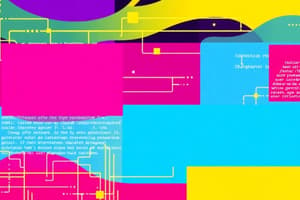Podcast
Questions and Answers
What is computer science primarily the study of?
What is computer science primarily the study of?
- Construction of buildings
- Culinary arts
- Computation and information (correct)
- Automobile mechanics
Which of the following is a core area of computer science?
Which of the following is a core area of computer science?
- Astronomy
- Programming Languages (correct)
- Marine biology
- Literary criticism
What does the theory of computation primarily focus on?
What does the theory of computation primarily focus on?
- The design of skyscrapers
- The capabilities and limitations of computers (correct)
- The history of art
- The study of the solar system
What is an algorithm?
What is an algorithm?
Which of the following is a common data structure?
Which of the following is a common data structure?
What is the purpose of a compiler?
What is the purpose of a compiler?
What is the function of the CPU?
What is the function of the CPU?
What is the primary role of an operating system?
What is the primary role of an operating system?
What is the purpose of a database?
What is the purpose of a database?
What is machine learning?
What is machine learning?
What is the SDLC?
What is the SDLC?
What are network topologies?
What are network topologies?
What is cloud computing?
What is cloud computing?
What is the focus of Human-Computer Interaction (HCI)?
What is the focus of Human-Computer Interaction (HCI)?
What is cryptography?
What is cryptography?
Which of these is a key element of computer architecture?
Which of these is a key element of computer architecture?
What is SQL primarily used for?
What is SQL primarily used for?
What is the purpose of 'Software Testing' in software engineering?
What is the purpose of 'Software Testing' in software engineering?
What does the acronym TCP/IP stand for in computer networks?
What does the acronym TCP/IP stand for in computer networks?
What is the focus of 'Computer Vision' in the field of Artificial Intelligence?
What is the focus of 'Computer Vision' in the field of Artificial Intelligence?
Flashcards
Computer Science
Computer Science
The study of computation and information.
Algorithms and Data Structures
Algorithms and Data Structures
Efficient methods for solving computational problems and organizing data.
Programming Languages
Programming Languages
Tools for expressing algorithms and instructing computers.
Computer Architecture
Computer Architecture
Signup and view all the flashcards
Operating Systems
Operating Systems
Signup and view all the flashcards
Databases
Databases
Signup and view all the flashcards
Artificial Intelligence
Artificial Intelligence
Signup and view all the flashcards
Computability Theory
Computability Theory
Signup and view all the flashcards
Automata Theory
Automata Theory
Signup and view all the flashcards
Complexity Theory
Complexity Theory
Signup and view all the flashcards
Algorithm
Algorithm
Signup and view all the flashcards
Data Structure
Data Structure
Signup and view all the flashcards
Syntax
Syntax
Signup and view all the flashcards
Semantics
Semantics
Signup and view all the flashcards
CPU (Central Processing Unit)
CPU (Central Processing Unit)
Signup and view all the flashcards
Memory
Memory
Signup and view all the flashcards
Resource Management
Resource Management
Signup and view all the flashcards
Relational Databases
Relational Databases
Signup and view all the flashcards
Machine Learning
Machine Learning
Signup and view all the flashcards
Software Development Life Cycle (SDLC)
Software Development Life Cycle (SDLC)
Signup and view all the flashcards
Study Notes
- Computer science is the study of computation and information
- Deals with the theory, design, development, and application of computers and computer systems
Core Areas
- Algorithms and Data Structures: Designing efficient methods for solving computational problems and organizing data
- Programming Languages: Creating and understanding tools for expressing algorithms and instructing computers
- Computer Architecture: Designing and organizing the hardware components of computer systems
- Operating Systems: Managing computer resources and providing a platform for software applications
- Databases: Designing and managing systems for storing and retrieving large amounts of data
- Artificial Intelligence: Developing systems that can perform tasks that typically require human intelligence
Theory of Computation
- Focuses on the fundamental capabilities and limitations of computers
- Computability Theory: Explores what problems can be solved by computers
- Automata Theory: Deals with abstract machines and their computational power
- Complexity Theory: Classifies problems based on their inherent difficulty
Algorithms and Data Structures
- Algorithm: A step-by-step procedure for solving a problem
- Data Structure: A way of organizing and storing data to facilitate efficient access and modification
- Common Algorithms: Sorting, searching, graph traversal, dynamic programming
- Common Data Structures: Arrays, linked lists, trees, graphs, hash tables
Programming Languages
- Syntax: The rules that define the structure of a programming language
- Semantics: The meaning of the instructions written in a programming language
- Paradigms: Different styles of programming, such as imperative, object-oriented, functional, and logical
- Compilers: Translate high-level programming languages into machine code
Computer Architecture
- CPU (Central Processing Unit): The "brain" of the computer, responsible for executing instructions
- Memory: Storage for data and instructions
- Input/Output Devices: Allow the computer to interact with the external world
- Buses: Communication pathways between components
Operating Systems
- Resource Management: Allocating resources such as CPU time, memory, and I/O devices
- Process Management: Managing the execution of programs
- Memory Management: Allocating and managing memory space
- File Systems: Organizing and storing files
Databases
- Relational Databases: Organize data into tables with rows and columns
- NoSQL Databases: Offer flexible data models for handling unstructured or semi-structured data
- Database Management Systems (DBMS): Software for creating, managing, and accessing databases
- SQL (Structured Query Language): A standard language for interacting with relational databases
Artificial Intelligence
- Machine Learning: Training computers to learn from data without explicit programming
- Deep Learning: Using artificial neural networks with multiple layers to learn complex patterns
- Natural Language Processing (NLP): Enabling computers to understand and process human language
- Computer Vision: Enabling computers to "see" and interpret images
- Robotics: Designing and building robots that can perform tasks autonomously
Software Engineering
- Software Development Life Cycle (SDLC): A process for planning, designing, developing, testing, and deploying software
- Requirements Engineering: Gathering and analyzing user needs
- Software Design: Creating a blueprint for the software system
- Software Testing: Verifying that the software meets the requirements and is free of defects
- Software Maintenance: Modifying and updating the software after deployment
Computer Networks
- Network Topologies: The physical or logical arrangement of a network
- Protocols: Rules that govern communication between devices
- TCP/IP: The foundation of the Internet
- Network Security: Protecting networks from unauthorized access and cyber threats
Distributed Systems
- Systems in which components located on networked computers communicate and coordinate their actions
- Cloud Computing: Delivering computing services over the Internet
- Parallel Computing: Using multiple processors to solve a problem simultaneously
- Concurrency Control: Managing access to shared resources in a multi-threaded environment
Human-Computer Interaction (HCI)
- Designing user interfaces that are easy to use and efficient
- Usability Testing: Evaluating the effectiveness of a user interface
- User Experience (UX): The overall experience a user has when interacting with a computer system
Graphics and Visualization
- Computer Graphics: Creating images and animations using computers
- Visualization: Representing data visually to gain insights
Security and Cryptography
- Cryptography: The art and science of secret writing
- Authentication: Verifying the identity of a user or device
- Authorization: Granting access to resources based on identity
- Security Vulnerabilities: Weaknesses in a system that can be exploited
- Ethical Hacking: Testing systems for vulnerabilities
Emerging Trends
- Quantum Computing: Using quantum mechanics to solve complex problems
- Blockchain: A distributed ledger technology
- Internet of Things (IoT): Connecting everyday objects to the Internet
- Big Data: Processing and analyzing extremely large datasets
Studying That Suits You
Use AI to generate personalized quizzes and flashcards to suit your learning preferences.




